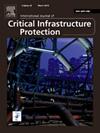An efficient convolutional neural network based attack detection for smart grid in 5G-IOT
IF 5.3
3区 工程技术
Q1 COMPUTER SCIENCE, INFORMATION SYSTEMS
International Journal of Critical Infrastructure Protection
Pub Date : 2025-01-03
DOI:10.1016/j.ijcip.2024.100738
引用次数: 0
Abstract
The deployment of 5G networks and IoT devices in smart grid applications provides electricity-generated, distributed, and managed bidirectional transmission of real-time information between utility providers and consumers. However, this increased transmission and confidence in IoT devices also present novel security challenges, since they are vulnerable to malicious attacks. Ensuring robust attack detection mechanisms in 5G-IoT smart grid systems for reliable and efficient power distribution, and early accurate identification of attacks addressed. To solve these concerns, a novel technique called Target Projection Regressed Gradient Convolutional Neural Network (TPRGCNN) is introduced to improve the accuracy of attack detection during data transmission in a 5G-IoT smart grid environment. The TPRGCNN method is combined with feature selection and classification for improving secure data transmission by detecting attacks in 5G-IoT smart grid networks. In the feature selection process, TPRGCNN utilizes the Ruzicka coefficient Dichotonic projection regression method and aims to enhance the accuracy of attack detection while minimizing time complexity. Then selected significant features are fed into Jaspen’s correlative stochastic gradient convolutional neural learning classifier for attack detection. Classification indicates whether transmission is normal or an attack in the 5G-IoT smart grid network. The implementation results demonstrate that the proposed TPRGCNN method achieve a 5% of improved attack detection accuracy and 2% improvement in precision, recall, F-score while reducing time complexity and space complexity by 13% and 23% compared to conventional methods.
基于卷积神经网络的5G-IOT智能电网攻击检测
在智能电网应用中部署5G网络和物联网设备,可在公用事业供应商和消费者之间提供发电、分布式和受管理的实时信息双向传输。然而,物联网设备的传输和信心的增加也带来了新的安全挑战,因为它们很容易受到恶意攻击。确保5G-IoT智能电网系统中强大的攻击检测机制,实现可靠高效的配电,并及早准确识别攻击。为了解决这些问题,引入了一种名为目标投影回归梯度卷积神经网络(TPRGCNN)的新技术,以提高5G-IoT智能电网环境中数据传输过程中攻击检测的准确性。将TPRGCNN方法与特征选择和分类相结合,通过检测5G-IoT智能电网中的攻击,提高数据传输的安全性。在特征选择过程中,TPRGCNN采用Ruzicka系数二分性投影回归方法,旨在提高攻击检测的准确性,同时最小化时间复杂度。然后将选取的显著特征输入Jaspen相关随机梯度卷积神经学习分类器进行攻击检测。分类是指在5G-IoT智能电网中传输是正常还是受到攻击。实施结果表明,与传统方法相比,提出的TPRGCNN方法的攻击检测准确率提高了5%,精度、召回率、f分数提高了2%,时间复杂度和空间复杂度分别降低了13%和23%。
本文章由计算机程序翻译,如有差异,请以英文原文为准。
求助全文
约1分钟内获得全文
求助全文
来源期刊

International Journal of Critical Infrastructure Protection
COMPUTER SCIENCE, INFORMATION SYSTEMS-ENGINEERING, MULTIDISCIPLINARY
CiteScore
8.90
自引率
5.60%
发文量
46
审稿时长
>12 weeks
期刊介绍:
The International Journal of Critical Infrastructure Protection (IJCIP) was launched in 2008, with the primary aim of publishing scholarly papers of the highest quality in all areas of critical infrastructure protection. Of particular interest are articles that weave science, technology, law and policy to craft sophisticated yet practical solutions for securing assets in the various critical infrastructure sectors. These critical infrastructure sectors include: information technology, telecommunications, energy, banking and finance, transportation systems, chemicals, critical manufacturing, agriculture and food, defense industrial base, public health and health care, national monuments and icons, drinking water and water treatment systems, commercial facilities, dams, emergency services, nuclear reactors, materials and waste, postal and shipping, and government facilities. Protecting and ensuring the continuity of operation of critical infrastructure assets are vital to national security, public health and safety, economic vitality, and societal wellbeing.
The scope of the journal includes, but is not limited to:
1. Analysis of security challenges that are unique or common to the various infrastructure sectors.
2. Identification of core security principles and techniques that can be applied to critical infrastructure protection.
3. Elucidation of the dependencies and interdependencies existing between infrastructure sectors and techniques for mitigating the devastating effects of cascading failures.
4. Creation of sophisticated, yet practical, solutions, for critical infrastructure protection that involve mathematical, scientific and engineering techniques, economic and social science methods, and/or legal and public policy constructs.
 求助内容:
求助内容: 应助结果提醒方式:
应助结果提醒方式:


